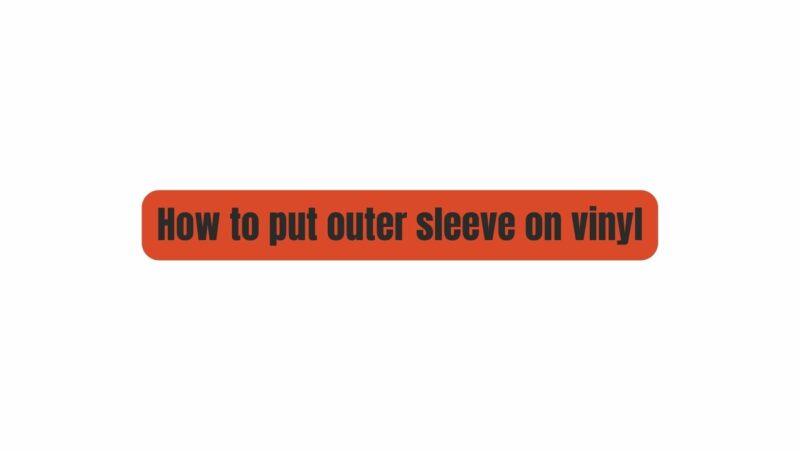Vinyl records, celebrated for their analog warmth and timeless allure, have witnessed a remarkable resurgence in the digital age. Collectors and enthusiasts alike understand the importance of protecting these cherished musical artifacts from the ravages of time, dust, and wear. One essential tool in preserving vinyl records is the outer sleeve. In this comprehensive guide, we’ll explore the art of applying outer sleeves to vinyl records, ensuring their longevity and sound quality are upheld for generations to come.
Understanding the Role of Outer Sleeves
Outer sleeves, also known as record sleeves or polythene sleeves, serve as protective shields for vinyl records. They play a crucial role in safeguarding records against various threats, including dust, moisture, physical damage, and the gradual wear and tear associated with handling and storage. Here are the primary benefits of using outer sleeves:
- Dust and Contaminant Protection: Outer sleeves create a barrier that shields records from dust, dirt, and contaminants that can accumulate on the record’s surface and affect sound quality.
- Scratch and Scuff Prevention: The added layer of protection minimizes the risk of scratches, scuffs, and abrasions caused by friction or handling.
- Moisture Resistance: Outer sleeves provide a degree of moisture resistance, guarding against potential water damage.
- Longevity Enhancement: Records stored in outer sleeves tend to age more gracefully, maintaining their pristine condition over time.
Choosing the Right Outer Sleeves
Before delving into the process of applying outer sleeves, it’s essential to select the right sleeves for your vinyl records. Here are some considerations when choosing outer sleeves:
- Size: Ensure that the outer sleeves you choose are appropriately sized for your records. Most standard outer sleeves fit both single LPs and double LPs, but larger sleeves may be necessary for box sets or oversized records.
- Material: Outer sleeves are commonly made of polyethylene or polypropylene. Both materials offer excellent protection, but some collectors have preferences based on factors like clarity and thickness.
- Clarity: Clarity refers to the transparency of the outer sleeves. Some collectors prefer crystal-clear sleeves that showcase the album artwork, while others opt for frosted or matte options for a more subdued appearance.
- Thickness: Outer sleeves come in various thicknesses, typically measured in microns. Thicker sleeves offer enhanced protection but may be less pliable. Consider your storage needs and preferences when selecting the thickness of the sleeves.
How to Properly Apply Outer Sleeves
Applying outer sleeves to vinyl records is a straightforward process when done with care. Follow these step-by-step instructions to ensure your records are properly protected:
Step 1: Gather Your Supplies
Before you begin, gather the following supplies:
- Vinyl records you want to sleeve
- Outer sleeves (properly sized and selected based on your preferences)
- Clean, dry surface or work area
- A soft cloth or microfiber towel (for cleaning records, if needed)
Step 2: Prepare the Work Area
Choose a clean, dry, and clutter-free surface to work on. Ensure that there’s ample space for you to handle the records and sleeves comfortably.
Step 3: Inspect the Records
Before sleeving your records, inspect them for any dirt, dust, or visible contaminants on the vinyl surface. If necessary, use a soft cloth or a microfiber towel to gently clean the records.
Step 4: Slide the Record into the Outer Sleeve
With clean hands, take the outer sleeve and hold it open. Gently slide the vinyl record into the outer sleeve. Ensure that the album cover or label is facing outward for easy identification.
Step 5: Seal the Outer Sleeve
Seal the outer sleeve. Most outer sleeves have a resealable flap or adhesive strip. Fold the flap down or use the adhesive strip to close the sleeve securely.
Step 6: Smooth Out Air Bubbles
If any air bubbles are trapped inside the sleeve, gently smooth them out by pressing on the sleeve’s surface. This ensures a snug fit and minimizes potential dust or moisture ingress.
Step 7: Repeat the Process
Repeat the process for each vinyl record you wish to sleeve, taking care to handle each record with clean hands and maintaining a clean work area.
Step 8: Store the Sleeved Records
Once your vinyl records are sleeved, store them vertically on a sturdy and flat surface, like a dedicated record shelf or crate. This helps maintain the integrity of the records and minimizes the risk of warping.
Conclusion: Preserving the Legacy of Vinyl Records
Applying outer sleeves to vinyl records is a simple yet vital practice in vinyl preservation. It ensures that your cherished records remain in pristine condition, allowing you to enjoy their analog warmth and timeless appeal for years to come. By choosing the right sleeves, handling records with care, and maintaining a clean work area, you can protect your vinyl collection and preserve its legacy for generations to appreciate.
Remember that vinyl records are more than just audio carriers; they are physical embodiments of music and memories. Each record tells a story, and the act of preserving them is an essential part of the vinyl experience.


